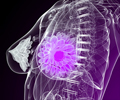A joint study conducted by Spanish and American has found that triple negative cancers and basal-like breast cancers are two different types of cancers.

The study conducted by the University of North Carolina and the Vall d'Hebron Institute of Oncology in Barcelona, Spain, was led by Charles Perou, PhD, of UNC Lineberger Comprehensive Cancer Center, and examined more than 1,700 breast tumors, including 412 triple negative (TN) breast cancers.
Breast cancers are sometimes classified into four main subtypes - basal-like (often called TN), luminal A, luminal B and HER2-enriched. While targeted therapies have been developed to exploit the weaknesses of some types of breast cancers, the lack of these drug markers on TN cancers means patients with these tumors must undergo broader, more aggressive therapies.
"This is clinically very important, because TN breast cancers lack the three biomarkers used for guiding many therapies in breast cancer, so those patients do not have these therapeutic options. They are thus left with multi-agent chemotherapy as their treatment," said Dr. Perou.
The researchers found at least four disease subtypes within TN tumors, with more than 75 percent of the tumors falling into the basal-like subtype.
Further research is needed to identify the distinct biomarkers shared by the expanded subtypes of TN cancers. The ultimate goal will be to target the individual biomarkers of these subtypes and create therapies that target their individual biology, according to Dr. Perou.
Advertisement
The study was published in the February issue of The Oncologist.
Advertisement















